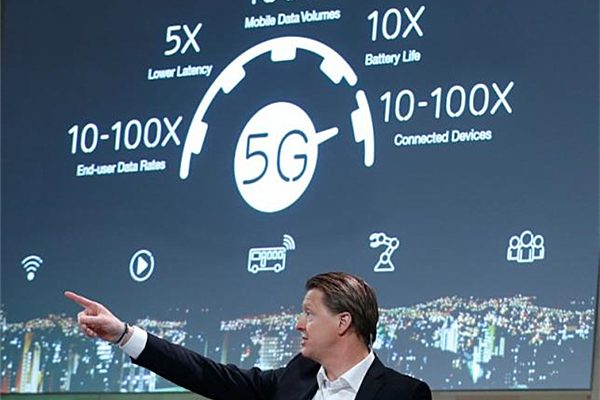North America and Asia Pacific are expected to lead the adoption of the super-fast, next-generation 5G mobile internet technology, according to a new report, but widespread use may need a big catalyst.
In its “Mobility Report” for June 2017, released on Wednesday, Swedish firm Ericsson said it expected more than half a billion 5G subscriptions worldwide by 2022, covering about 15 percent of the global population.
North America was projected to lead the adoption of this new technology, with 25 percent of mobile subscriptions set to be 5G by 2022, the report said. This was expected to be followed by Asia Pacific with 10 percent.
“There’s great interest from the major operators … we’ve seen statements from both Verizon and AT&T to deliver as early as possible. That’s why we believe North America will, in that regard, lead the introduction (of 5G),” Magnus Ewerbring, Asia Pacific CTO at Ericsson, told CNBC.
Ewerbring added, “We see corresponding similar statements from operators in predominantly (South) Korea, large, large interest in Japan and China as well.”
Last week, Japanese business daily Nikkei reported the country’s three leading mobile service providers — NTT Docomo, KDDI and SoftBank Group — were expected to invest a combined $45.7 billion to roll out 5G wireless communications services, starting in parts of Tokyo and other limited areas ahead of the 2020 summer Olympics in Tokyo.
In a note last week, Jefferies analyst Edison Lee said he expected Chinese telcos to invest as much as $180 billion in 5G between 2019 and 2025, amounting to about 13 months of industry revenue. Lee wrote Jefferies expected China to spend twice as aggressively on 5G than Japan.
Highlights of Contents
5G still needs a big push to take off
5G is still in its infancy, with the telecom industry investing heavily into the technology, carrying out trials and setting standards. The promise underpinning the technology is big: It is expected to support the burgeoning Internet of Things market , comprising billions of connected devices, and developments in artificial intelligence, virtual and augmented reality.
But some were not convinced that the promise of super-fast mobile internet will be enough to convince consumers to take up new, more expensive, services once they are available.
“The industry is making quite a bold assumption that consumers are going to take up 5G services the moment we achieve it,” John Hayduk, chief corporate operations officer at Tata Communications, told CNBC.
Hayduk said a good gauge to estimate how consumers will react to 5G is to look at the roll out of 4G networks.
“4G adoption was spurred by apps appearing on consumers’ phones, and the world of new functions those apps introduced. The problem was that the apps kept becoming more and more sophisticated — graphically and functionally — and (existing) 3G connections couldn’t keep up,” he said.
That, he said, created an easy choice for consumers: They could either give up the swanky new apps that populated the latest smartphones or upgrade to 4G networks for a relatively modest financial jump.
Similarly, the roll-out of 5G is also expected to introduce new applications that depend on super-fast connectivity.
“The challenge, however, is that the economics of providing 5G connectivity will make it difficult for providers to drive costs low enough to make moving to 5G more tempting than simply not adopting the latest app,” said Hayduk. “Without mass adoption of 5G for big apps, we won’t see mass adoption of 5G.”
Supporting connected devices, smart cities, robots
Ericsson estimated there will be around 18 billion connected devices related to IoT by 2022, including connected cars, machines, meters, sensors, consumer electronics and wearables. The nature of the devices, and the functions they perform, require low latency connectivity and high data throughput — something 5G is expected to provide.
The report also pointed out potential use-cases for having high-speed internet connectivity: for example, 5G can theoretically load 4K or 8K high-resolution videos on mobile quickly and enable AR/VR, or augmented reality and virtual reality, gaming. In the manufacturing space, it can allow remote control of robots to perform tasks, while in the healthcare industry, it can facilitate remote robotic surgery.
Smart city projects can also benefit from 5G connectivity, according to a spokesperson from Chinese communications technology services provider Huawei. The representative told CNBC, “5G will provide the foundation structures for building smart and safe cities, which will push mobile network performance … to their extremes.”
Challenges ahead for operators
Despite growing buzz around 5G, there are still significant questions that need answers before the technology is rolled out.
“Not least, the question of who will pay for the infrastructure to deploy it,” said Hayduk. “What’s more, we don’t even have complete 4G coverage yet, even in big cities where signal can be patchy.”
In Asia Pacific, the lack of basic mobile broadband coverage, geographical differences, and unavailability of significant funding are challenges that need to tackled before rolling out 5G, according to Huawei. But there’s a silver lining, said the spokesperson: the lack of legacy systems provide an opportunity for countries to leapfrog their progress to 5G.
“National (information and communication technology) plans are crucial,” the spokesperson added.
Before companies can roll out services, regulators also need to work quickly on allocation of frequency space for 5G, according to Ewerbring.
He said, “Our big encouragement to every regulatory body is to work … on releasing 5G spectrum and large amounts of it. Any country that, for whatever reason, is not able to do so, runs the risk of setting back the local community because 5G cannot be launched.”
The Ericsson report noted that the speed of 5G network deployment will depend on the growth of the complete ecosystem, including the availability of 5G-enabled devices and decisions on spectrum allocation.
“It is expected that many operators will deploy 5G commercially from 2020, in line with the time plan for 5G standardization,” the report added.
Thanks: CNBC
